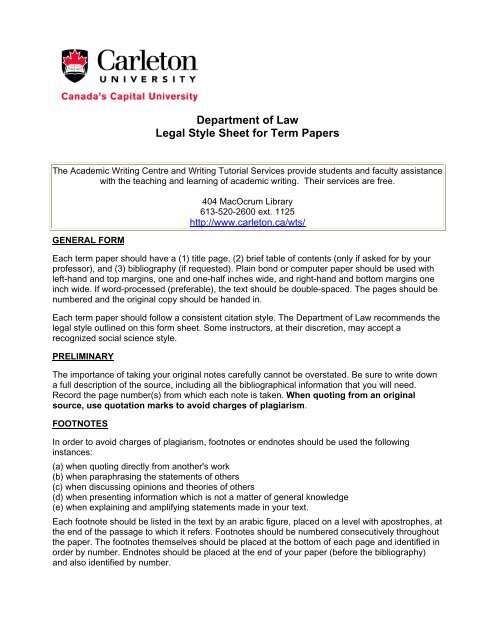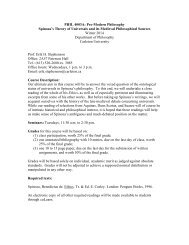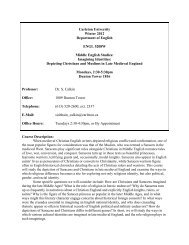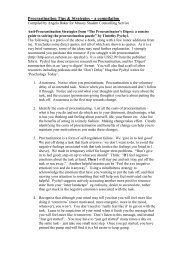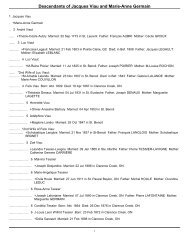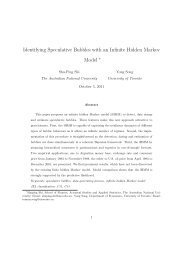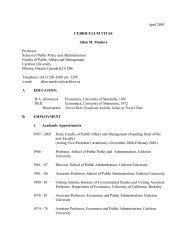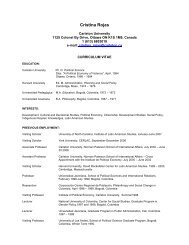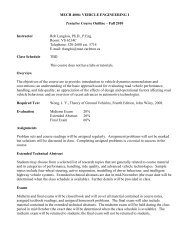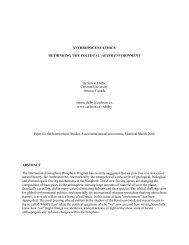Legal Style Sheet for Term Papers - Carleton University
Legal Style Sheet for Term Papers - Carleton University
Legal Style Sheet for Term Papers - Carleton University
You also want an ePaper? Increase the reach of your titles
YUMPU automatically turns print PDFs into web optimized ePapers that Google loves.
Department of Law<strong>Legal</strong> <strong>Style</strong> <strong>Sheet</strong> <strong>for</strong> <strong>Term</strong> <strong>Papers</strong>The Academic Writing Centre and Writing Tutorial Services provide students and faculty assistancewith the teaching and learning of academic writing. Their services are free.GENERAL FORM404 MacOcrum Library613-520-2600 ext. 1125http://www.carleton.ca/wts/Each term paper should have a (1) title page, (2) brief table of contents (only if asked <strong>for</strong> by yourprofessor), and (3) bibliography (if requested). Plain bond or computer paper should be used withleft-hand and top margins, one and one-half inches wide, and right-hand and bottom margins oneinch wide. If word-processed (preferable), the text should be double-spaced. The pages should benumbered and the original copy should be handed in.Each term paper should follow a consistent citation style. The Department of Law recommends thelegal style outlined on this <strong>for</strong>m sheet. Some instructors, at their discretion, may accept arecognized social science style.PRELIMINARYThe importance of taking your original notes carefully cannot be overstated. Be sure to write downa full description of the source, including all the bibliographical in<strong>for</strong>mation that you will need.Record the page number(s) from which each note is taken. When quoting from an originalsource, use quotation marks to avoid charges of plagiarism.FOOTNOTESIn order to avoid charges of plagiarism, footnotes or endnotes should be used the followinginstances:(a) when quoting directly from another's work(b) when paraphrasing the statements of others(c) when discussing opinions and theories of others(d) when presenting in<strong>for</strong>mation which is not a matter of general knowledge(e) when explaining and amplifying statements made in your text.Each footnote should be listed in the text by an arabic figure, placed on a level with apostrophes, atthe end of the passage to which it refers. Footnotes should be numbered consecutively throughoutthe paper. The footnotes themselves should be placed at the bottom of each page and identified inorder by number. Endnotes should be placed at the end of your paper (be<strong>for</strong>e the bibliography)and also identified by number.
THE COMPLETE CITATIONThe first time a work is cited in a footnote or endnote complete bibliographical in<strong>for</strong>mation shouldbe given.EXAMPLES FOR BOOKSA full citation includes author's name, title (underlined or italicized), volume number (if any), placeof publication, publisher, date and pinpoint. (A pinpoint is a reference to a specific page orparagraph number.)One author:1 G. Parker, An Introduction to Criminal Law (Toronto: Methuen, 1983) at 73.Joint authors:2 R.H. Floyd, C.S. Gray & R.P. Short, Public Enterprises in Mixed Economies (Washington, D.C.:International Monetary Fund, 1984).More than three authors, cite only the first author and use "et al.":3 J.B. Laskin et al., Debtor and Creditor: Cases, Notes, and Materials, 2d ed. (Toronto: <strong>University</strong>of Toronto Press, 1982).Editor of a collection as author:4 W.T. McGrath, ed., Crime and its Treatment in Canada (Toronto: Gage Publishing Limited, 1980).EXAMPLES OF JOURNAL ARTICLESA full citation includes author's name, title of article (in quotes), year of publication, volume number,name of journal, page and pinpoint.One author:5 M.R. Goode, "Mens Rea in Corpore Reo: An Exploration of the Rapists' Charter" (1983) 7Dalhousie L. J. 447 at 448.Joint authors:6 G.A. Ferguson & D.W. Roberts, "Plea Bargaining: Directions <strong>for</strong> Canadian Re<strong>for</strong>m" (1974) 52Can. Bar Rev. 497 at 503.SHORTENED FORM OF CITATIONUse this shortened <strong>for</strong>m only when complete citation has already been used in an earlier footnoteor endnote. Include only author's surname, a reference to the earlier footnote or endnote, and thepage references.EXAMPLE7 Parker, supra note 1 at 8. (Note: supra is Latin <strong>for</strong> "above")If the work being cited is the same as that immediately above it, Ibid., may be used.EXAMPLE8 Parker, supra note 1 at 8.9 Ibid. at 10.
CASESCases decided in different courts in various jurisdictions have been collected and printed in seriesof case reports. One series of case reports usually deals with cases from one jurisdiction, casesfrom one level of court or cases concerning one legal subject. For example, in Ontario, the OntarioReports report cases decided in Ontario. An example of a series of case reports dealing with oneparticular legal topic is Canadian Criminal Cases, which is a collection of cases from all acrossCanada that relate to criminal law matters.When referring to a case reported in a series of case reports, the citation of the case is given sothat others can find the full text of the decision if they wish. Cases are always cited as follows:name of the case, date of the decision or the volume of the series in which the case is found,volume number, name of the law reports, series, page number, name of the court giving thedecision. If the date is given in square brackets, that means the date is important in finding thecorrect volume of the reports; each year the volume numbers start over again (i.e. there arevolumes 1,2, and 3 in each year). Sometimes, only one volume exists <strong>for</strong> each year and only adate is given in square brackets. If the date is given in round brackets, then it is not required to findthe case. You merely have to look at the volume number.EXAMPLESR. v. Stanley (1977), 36 C.C.C. (2d) 216 (B.C.C.A.)R. v. Landry, [1991] 1 S.C.R. 99 at 110, 62 C.C.C. (3d) 117, Lamer C.J.EXAMPLES OF FREQUENTLY USED LAW REPORTS SERIESC.C.C. Canadian Criminal Cases (criminal law cases - Canada)R.F.L. Reports of Family Law (family law cases - Canada)O.R. Ontario Reports (cases from Ontario)O.L.R. Ontario Law Reports (old series - no longer used)O.W.N. Ontario Weekly Notes (old series - no longer used)W.W.R. Western Weekly Reports (cases - Western Canada)D.L.R. Dominion Law Reports (cases from all of Canada)S.C.R. Supreme Court Reports (cases from the Supreme Court of Canada)All E.R. All England Law Reports (cases from England and other parts of the Commonwealth)Please note that there are often more than one series of any particular law report. For example,there are four series of the Dominion Law Reports, three of Reports of Family Law, and two of theOntario Reports. The series are indicated as follows:First series: (1976), 25 R.F.L. 213Second series: (1981), 18 R.F.L. (2d) 400Third series: (1987), 6 R.F.L. (3d) 234LEGISLATIONCitation of legislation should include the title of the statute, statute volume, the jurisdiction, theyear, the chapter number and pinpoint.EXAMPLESCanada Evidence Act, R.S.C. 1970, c. E-10, s.19(a).City of Moncton Act, 1990, S.N.B. 1990, c. 69.BIBLIOGRAPHYAt the end of the paper, after footnotes and/or endnotes, list all books, pamphlets, articles,newspapers, document, legislation, etc., which you used in preparation of the paper. Refer also tointerviews conducted. All but the first line of each reference should be indented. In the
ibliography, authors are cited by giving the last name first and alphabetically. You may wish tolist cases and legislation separately from other sources used.EXAMPLESFloyd, R.H., C.S. Gray & R.P. Short, Public Enterprises in Mixed Economies, (Washington, D.C.:International Monetary Fund, 1984).Goode, M.R., "Mens Rea in Corpore Reo: An Exploration of the Rapists' Charter" (1983) 7Dalhousie Law Review 447.Parker, G., An Introduction to Criminal Law, (Toronto: Methuen, 1983).For a more detailed discussion of citation, refer to other style handbooks. Examples of legalhandbooks are:McGill Law Journal, Canadian Guide to Uni<strong>for</strong>m <strong>Legal</strong> Citation, 4th ed. (Toronto: Carswell, 1998).MacEllven, D.T., <strong>Legal</strong> Research Handbook, 3d ed. (Toronto: Butterworths, 1993).~~~~~~~~~~~~~~~~~Standards <strong>for</strong> Electronic Distribution and Citation of Canadian JudgmentsPrepared by Martin Felsky - March 1, 1995For the Judges' Computer Advisory Committee of the Canadian Judicial CouncilQUICKLAWMost judges use the reference which Quicklaw itself provides on each judgment, which is "[1992]O.J. No. 1827." The QL document number should never be used, since the document numbering isan internal reference only and may change as the database is updated.Hugh v. Roy [1993] O.J. No. 422 (Ont GD)PARAGRAPH REFERENCEWhere the cite is to Quicklaw and the judgment has paragraph numbering, the paragraph numbershould be used. The proper cite is [1993] F.C.J. No. 210, para 97. (It has been suggested that itwould be helpful if all pinpoint references could indicate the total length of the judgment, as such:[1993] F.C.J. No. 210, para 97 of 457 (TD).)Pinpoint references would generally appear:Hugh v. Roy [1993] O.J. No. 422, para 76 (Ont GD)INTERNETThe emerging standard <strong>for</strong> file reference on the Internet, the URL, should be adopted.See also <strong>Carleton</strong> <strong>University</strong> Library's Web Page, How do I Cite my Sources athttp://www.library.carleton.ca/howdoI/citing.html


